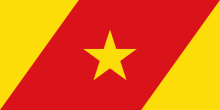Kobo (woreda)
Kobo or Raya Kobo (Amharic: ራያ ቆቦ) is one of the woredas in the Amhara Region of Ethiopia. Located in the northeast corner of the Semien Wollo Zone, Kobo is bordered on the south by the Logiya River which separates it from Habru and Guba Lafto, on the west by Gidan, on the north by Tigray Region, and on the east by the Afar Region. Towns in Kobo include Gobiye, Kobo and Robit (Kobo Robit).
Raya Kobo ራያ ቆቦ | |
|---|---|
Woreda | |
 Flag | |
| Zone | Semien Wollo |
| Region | Amhara Region |
| Area | |
| • Total | 2,001.57 km2 (772.81 sq mi) |
| Population (2012 est.) | |
| • Total | 244,046 |
Overview
The landscape of this woreda is characterized by a broad fertile plain which is separated from the lowlands of the Afar Region by the Zobil mountains, which are over 2000 meters high. In general, the altitude of Kobo ranges from 1100 meters on the plains to slightly more than 3000 meters above sea level along the border with Gidan.[2] Kobo, as well as the other seven rural woredas of this Zone, has been grouped amongst the 48 woredas identified as the most drought prone and food insecure in the Amhara Region.[3] To combat increasing droughts and improve crop yields, two irrigation projects have been undertaken in this woreda by the Commission for Sustainable Agriculture and Environmental Rehabilitation in the Amhara Region and the NGO Lutheran World Federation, affecting 302 hectares and benefiting 1,017 households.[4]
The northern part of Kobo woreda is traversed from west to southeast by Hormat River. The river passes south of Zobil Mountains.
The woreda Agriculture and Rural Development Office announced 8 April 2007 that it was starting a program to improve the livelihood of woreda inhabitants, affecting 53,000 farmers. This would use 23.3 million birr of Regional funds to develop basin and degraded mountains, construct all weather roads and irrigation diversion canals, improve springs as well as various "water harvesting structures". A similar program initiated a few years previously led to a decline in the number of farmers migrating to the Afar Region, Djibouti and Sudan.[5]
In December 2008, construction on a 2.5 kilometer flood wall was completed, which would protect hundreds of hectares of farmland from frequent flooding by the Dikalla river.[6]
Demographics
Based on the 2007 national census conducted by the Central Statistical Agency of Ethiopia (CSA), this woreda has a total population of 221,958, an increase of 26.43% over the 1994 census, of whom 111,605 are men and 110,353 women; 33,142 or 14.93% are urban inhabitants. With an area of 2,001.57 square kilometers, Kobo has a population density of 110.89, which is less than the Zone average of 123.25 persons per square kilometer. A total of 54,466 households were counted in this woreda, resulting in an average of 4.08 persons to a household, and 52,108 housing units. The majority of the inhabitants practiced Ethiopian Orthodox Christianity, with 82.88% reporting that as their religion, while 16.5% of the population said they were Muslim.[7]
The 1994 national census reported a total population for this woreda of 175,558 in 37,031 households, of whom 87,636 were men and 87,922 were women; 28,706 or 16.35% of its population were urban dwellers. The two largest ethnic groups reported in Kobo were the Amhara (98.63%), and the Tigrayan (1.26%); all other ethnic groups made up 0.11% of the population. Amharic was spoken as a first language by 98.45%, and Tigrinya was spoken by 1.47%; the remaining 0.08% spoke all other primary languages reported. The majority of the population practiced Ethiopian Orthodox Christianity with 83.2% reported to profess this belief, while 16.72% of the population said they were Muslim.[8]
Notes
- Geohive: Ethiopia Archived 2012-08-05 at the Wayback Machine
- Svein Ege, "North Wälo 1:100,000. Topographic and administrative map of North Wälo Zone, Amhara Region, Ethiopia" Archived 2011-07-18 at the Wayback Machine. Trondheim, NTNU, 2002
- Seid Yassin, "Small-Scale Irrigation and Household Food Security: A Case Study of Three Irrigation Schemes in Gubalafto Woreda of North Wollo Zone, Amhara Region" Archived 2011-07-20 at the Wayback Machine, Master's Thesis, Graduate School of the University of Addis Ababa (June 2002), p. 35
- Seid Yassin, "Small-Scale Irrigation", p. 42
- "Woreda implementing over 23mln birr food security projects" (Walta Information Center)
- "Flood wall worth over 6 mln Birr constructed" Archived 2009-02-12 at the Wayback Machine, Ethiopian News Agency (accessed 29 April 2009)
- Census 2007 Tables: Amhara Region Archived 2010-11-14 at the Wayback Machine, Tables 2.1, 2.4, 2.5, 3.1, 3.2 and 3.4.
- 1994 Population and Housing Census of Ethiopia: Results for Amhara Region, Vol. 1, part 1 Archived 2010-11-15 at the Wayback Machine, Tables 2.1, 2.7, 2.10, 2.13, 2.17, Annex II.2 (accessed 9 April 2009)